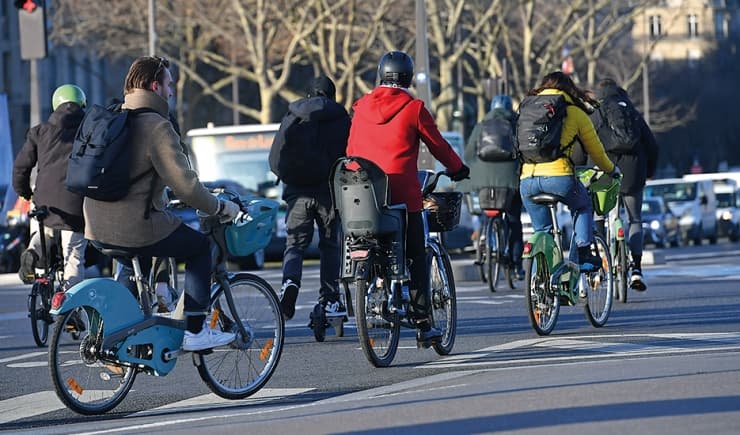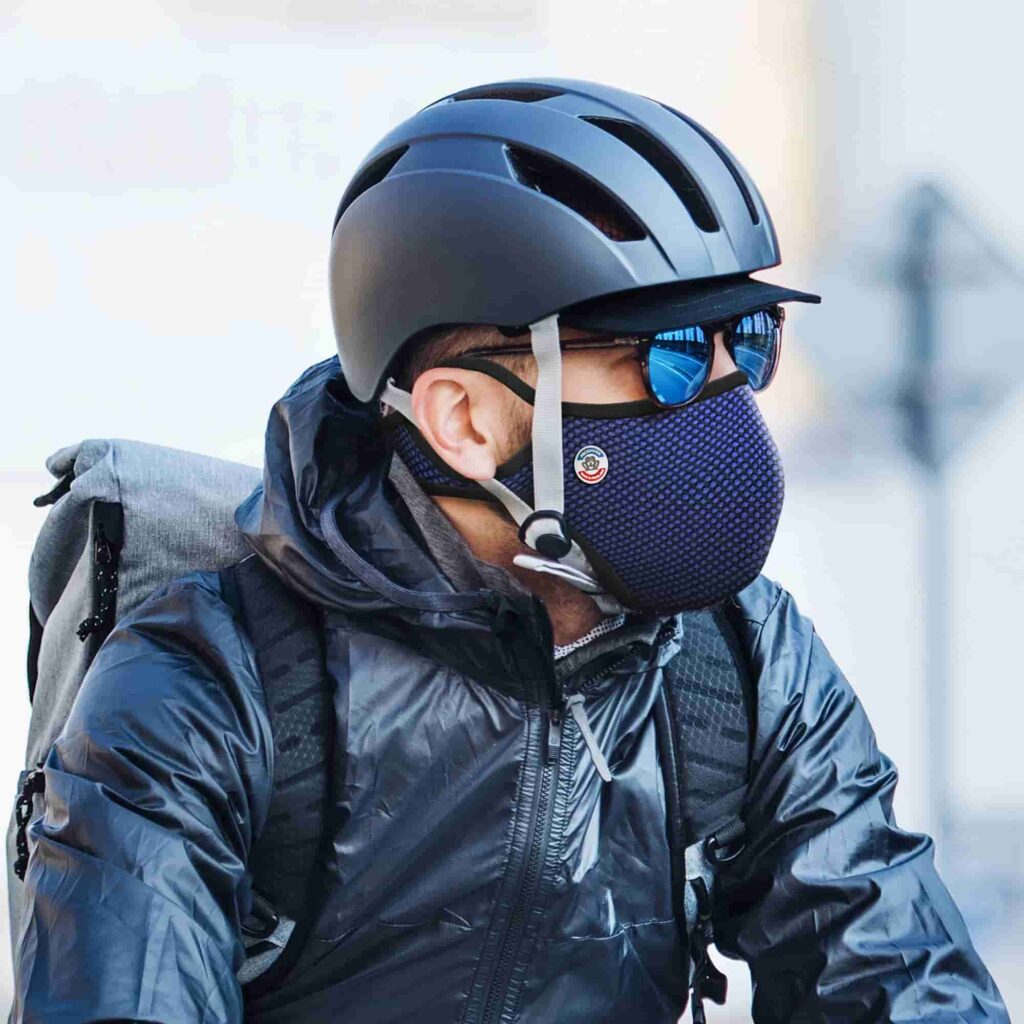
The self-service bike fleets available in major cities since the early 2000s paved the way for short urban bike trips. But it’s really been since the 2020 Covid crisis, once the loockdowns and gradual reduction of commuting had passed, that the number of city dwellers cycling to work has literally exploded. There are a number of reasons for this urban cycling craze. Let’s take a look at the cycling to work benefits, and how to get the right equipment ?
What is Cycling to work movement ?
Cycling to work or bike commuting has become the accepted term for commuting to work or business meetings by bike or whatever the soft mobility vehicle you use.
The first bike commuters tended to come from the executive population, i.e. the affluent classes, living in city centers not far from their offices, not wishing to mix with the crowds of public transport and save time. Since then, they have been joined by all types of employees, with the possible exception of craftsmen who generally need to transport a lot of equipment. Some try their hand at this with cargo bikes, the use of which has also exploded in recent years. We’re even seeing more and more parents equipped with special bikes like longtails, dropping their children off at school on their way.
What is the average distance cycled between home and work?
You’re probably wondering whether you could consider cycling to work? I found on the internet the figure of 12Km for the average distance cycled from home to work.
Statistics show that a person in average physical condition can cover 15Km in an hour with a conventional muscle bike, and between 20 and 25Km with an electric bike. These figures can vary enormously depending on whether you use cycle paths, their quality and whether you live in a highly urbanized area or in the countryside.
From this we can deduce that the average journey time is around 30 to 45 minutes in built-up areas.
The 1st reason for cycling to work : getting away from public transport
During the pandemic, public transport was the last place you’d want to go, because it’s so crowded, even with a protective mask. Travelling above ground in the open air was a strong motivation for workers who had to get to the office.
Anyone who has ever taken the metro during rush hour will easily understand why it’s better to find an alternative when you can. It’s not very compatible with “social distancing”.
Not being dependent on breakdowns, “passenger accidents” and strikes is a real plus. It allows you to control your time and never be late for work or an appointment.
Some studies show that the air in the metro is more polluted than the air outside. But that’s probably not the main reason for preferring the bike to the metro, as this information is not widely publicized.
Finally, it’s more economical. An annual subscription costs several hundred euros. It’s not necessarily cost-effective for those who continue to telecommute several days a week, and buying individual tickets quickly becomes very expensive.
Daily cycling is very good for your health
Physical exercise releases endorphins, the hormones associated with joy and good mood, as well as dopamine (a feeling of pleasure) and serotonin, a hormone with anti-depressant properties that facilitates sleep and rest. Employees who cycle to work are found to be absent less often, as they are more motivated, less tired and more focused in their work.
Cycling is good for the body because it’s a real physical activity. And with all the benefits it brings, exercise also helps free your mind from stress and work, so you can arrive at work and go home much more relaxed… provided you don’t have to drive too much in traffic.
Cycling is THE solution for strengthening our immune, cardiovascular and pulmonary systems, preventing certain diseases and reducing our susceptibility to fatigue and stress. Regular pedaling keeps you healthy and helps you perform better at work.
A study of 269 people published in the Journal of Occupational Health Psychology shows that exercising before going to the office is even more beneficial. Subjects who exercised before work saw office problems as challenges to be overcome. They find their goals more attainable. They worry less about the difficulties they’ll encounter. The result? More commitment at work, less emotional fatigue and less professional anxiety.
In other words, if sport improves your performance, it’s not just because it helps you recover: it’s also because it changes, positively, your vision of work. Set your alarm earlier… or arrive a little later! Why hesitate any longer?
Cycling to work costs less than other means of transport
The economic argument is easy to understand, and is one of the top criteria for those who switch to cycling in the city. The savings on public transport fares can add up to several hundred euros a year. Enough to finance the purchase of a bike for those, like students or young professionals, with limited purchasing power.
Here are a few examples of how you can save money by cycling instead of using a motor vehicle.
- Cheaper to buy: a bike costs much less than a 2- or 4-wheel motorized vehicle.
- No fuel: with a conventional bike, the engine is your muscles; with an electric bike, it costs you a few cents for electricity.
- No parking: this is becoming a hot topic now that motorized 2-wheelers have to pay parking fees of up to €6 an hour in Paris.
- Less maintenance: bikes cost very little to service, and can be serviced by their owners.
- No compulsory insurance, although recommended given the price of some electric bikes and the upsurge in thefts.
Cycling is the fastest way to get around town
Crossing the city by bike is much quicker than by car, public transport or on foot, even if you don’t go through a red light! For short distances of less than 5km (i.e. more than half of all intra-urban journeys), cycling is unbeatable.
Bike lanes development will obviously facilitate and shorten leadtimes increasing ever more the advantage of riding a bike rtaher than any other transportation mean.
According to the TomTom Traffic Index 2023, based on traffic conditions in almost 400 cities, it takes a motorist an average of 26min30 to cover 10km in Paris (i.e. La Défense – Le Louvre). Only 11 cities in the world do worse!
Cycling to work is the most environmentally-friendly form of transport, alongside walking
Bikes stand out for their versatility, accessibility and, above all, their very low carbon footprint. Nothing to do with cars or motorcycles.
Numerous studies link the rise in cardio-respiratory diseases, allergies and other ailments such as asthma to the increase in pollution in urban areas. The containment period saw a remarkable reduction in pollution in major cities, mainly due to the drastic reduction in automobile traffic. This trend suggests that, even in areas where significant changes have not yet been observed, tighter restrictions on car traffic could be implemented in the future, benefiting alternative modes of transport and soft mobility such as cycling.
Urban cycling is a new social connector
There are countless Facebook and Instagram, Linkedin and Strava groups, as well as group outings at night and on weekends. Cycling in the city is becoming a way of making friends with similar interests.
A recent study carried out by the French Bike Observatory and Sport Heroes company shows that 61% of cyclists are aged between 21 and 35. This age group is highly connected and has more free time. A real boon for making friends when you arrive in a new city, whether for study or work.
How to protect yourself when cycling to work ?
There are two types of protection you need to think about when cycling to work.
Clothing must be adapted to the weather so you don’t arrive at the office dripping with sweat in summer, freeze to death in winter or arrive drenched when it rains. Since 2020, many brands have entered this niche, offering capes, ponchos, waterproof jackets, overtrousers, overshoes…
The other protection is linked to the fact that cycling in urban areas is not without risk. The cohabitation of cyclists, motorcyclists, motorists, buses and trucks is unfortunately not always harmonious. There are a lot of accidents. Far too many urban cyclists still ride in traffic without the essential protective equipment such as helmets, gloves and anti-pollution masks. The latter has not yet become a habit and is still seen as a constraint by those who have suffered from wearing the compulsory paper surgical mask during Covid period. However, a bike face mask is still an excellent way of protecting yourself from pollution and exhaust fumes.

Which bike for bike commuting?
It’s a legitimate question, but a difficult one to answer. The type of bike you use to cycle to work will depend on :
- The distance you need to cover: an electric bike is a real plus for long distances.
- What you can afford: there are second-hand bikes for a few dozen euros, and others for several thousand, especially Ebikes.
- The possibility of parking it in a secure place: bike theft has multiplied with the explosion in use and demand. Don’t buy an overpriced bike if it’s going to be left on the street, even if securely fastened, day or night.
My advice would be to start with a bike that won’t cost you a payslip, to see if your new travel project is viable in the long term. You can always upgrade later, or even have your employer finance it for you?
Mileage allowances and corporate bicycles
The practice is so virtuous that some companies have quickly realized the advantage of providing their employees with a company bike, or reimbursing them for kilometers covered on their personal bike. This is known as the “bicycle kilometre allowance” (BKA) in France, “bicycle allowance” in Belgium or “Cyclescheme” in the UK. The French government has also introduced a sustainable mobility package for employees who use an alternative means of transport to the car (bicycle, carpooling, public transport). The company is then exempt from taxes and contributions. This package cannot be combined with the BKA and cannot exceed €500 per employee per year.
Some companies make it part of their CSR (Corporate Social Responsibility) strategy proposing their own company bike fleet.
A whole economy has sprung up around corporate cycling, with long-term rental, maintenance, insurance and even courses to learn how to ride a bike and master its best practices.
A press article in the September 2021 issue of L’Equipe (Main French sport daily newspaper), echoing the benefits of cycling to work set out above, announces that the productivity gain for cycling employees is 12%. Employers beware ! Bike on !
